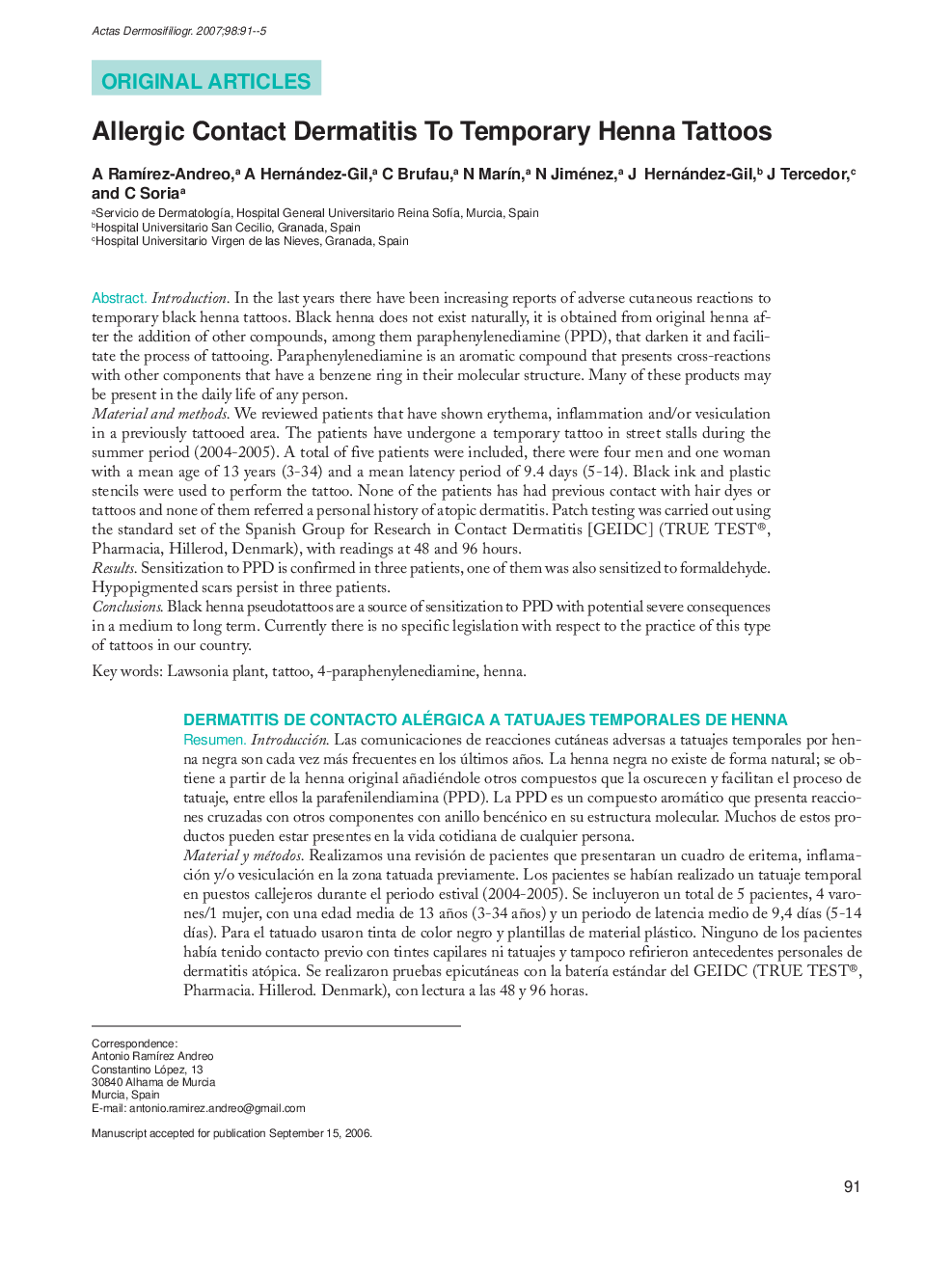| Article ID | Journal | Published Year | Pages | File Type |
|---|---|---|---|---|
| 3183988 | Actas Dermo-Sifiliográficas (English Edition) | 2007 | 5 Pages |
IntroductionIn the last years there have been increasing reports of adverse cutaneous reactions to temporary black henna tattoos. Black henna does not exist naturally, it is obtained from original henna after the addition of other compounds, among them paraphenylenediamine (PPD), that darken it and facilitate the process of tattooing. Paraphenylenediamine is an aromatic compound that presents cross-reactions with other components that have a benzene ring in their molecular structure. Many of these products may be present in the daily life of any person.Material and methodsWe reviewed patients that have shown erythema, inflammation and/or vesiculation in a previously tattooed area. The patients have undergone a temporary tattoo in street stalls during the summer period (2004-2005). A total of five patients were included, there were four men and one woman with a mean age of 13 years (3-34) and a mean latency period of 9.4 days (5-14). Black ink and plastic stencils were used to perform the tattoo. None of the patients has had previous contact with hair dyes or tattoos and none of them referred a personal history of atopic dermatitis. Patch testing was carried out using the standard set of the Spanish Group for Research in Contact Dermatitis [GEIDC] (TRUE TEST®, Pharmacia, Hillerod, Denmark), with readings at 48 and 96 hours.ResultsSensitization to PPD is confirmed in three patients, one of them was also sensitized to formaldehyde. Hypopigmented scars persist in three patients.ConclusionsBlack henna pseudotattoos are a source of sensitization to PPD with potential severe consequences in a medium to long term. Currently there is no specific legislation with respect to the practice of this type of tattoos in our country.
ResumenIntroducciónLas comunicaciones de reacciones cutáneas adversas a tatuajes temporales por henna negra son cada vez más frecuentes en los últimos años. La henna negra no existe de forma natural; se obtiene a partir de la henna original añadiéndole otros compuestos que la oscurecen y facilitan el proceso de tatuaje, entre ellos la parafenilendiamina (PPD). La PPD es un compuesto aromático que presenta reacciones cruzadas con otros componentes con anillo bencénico en su estructura molecular. Muchos de estos productos pueden estar presentes en la vida cotidiana de cualquier persona.Material y métodosRealizamos una revisión de pacientes que presentaran un cuadro de eritema, inflamación y/o vesiculación en la zona tatuada previamente. Los pacientes se habían realizado un tatuaje temporal en puestos callejeros durante el periodo estival (2004-2005). Se incluyeron un total de 5 pacientes, 4 varones/1 mujer, con una edad media de 13 años (3-34 años) y un periodo de latencia medio de 9,4 días (5-14 días). Para el tatuado usaron tinta de color negro y plantillas de material plástico. Ninguno de los pacientes había tenido contacto previo con tintes capilares ni tatuajes y tampoco refirieron antecedentes personales de dermatitis atópica. Se realizaron pruebas epicutáneas con la batería estándar del GEIDC (TRUE TEST®, Pharmacia. Hillerod. Denmark), con lectura a las 48 y 96 horas.ResultadosSe confirma una sensibilización a la PPD en 3 pacientes, en uno de ellos también a formaldehído. En 3 pacientes persisten las cicatrices hipopigmentadas.ConclusionesLos pseudotatuajes con henna negra son una fuente de sensibilización a PPD con consecuencias graves potenciales a medio-largo plazo. En la actualidad no existe ninguna ley que regule la práctica de este tipo de tatuajes en nuestro país.
